The Selective, High-Ball Hitting Eddie Rosario Is Legit
The tools hadn’t quite come together for Eddie Rosario until last year. Through his first two seasons, he had a penchant to swing often and at anything. While his power still made appearances, his overall line was diminished by his lack of selectivity at the plate, which resulted in far too many Ks compared to his bottom-of-the-barrel walk rate. In 2017, hitting coach James Rowson made note of Rosario’s focus on becoming an “all-around hitter,” and evidently, that had him heading in the right direction.
Part of becoming that kind of all-around hitter had to be closing the gap between his BB% and K%. After posting very poor BB% of 3.2% and 3.4% in his first couple seasons, Rosario made the jump to 5.9% last year and coupled that with a hefty decrease in Ks as well — from around 25% to 18.0%. And this was hardly a fluke. Rosario has swung less and less over his three seasons in the majors, and that decrease in Swing% has been due almost entirely to a decrease in O-Swing%.
| Year | O-Swing% | Z-Swing% | Swing% | F-Strike% | SwStr% |
| 2015 | 45.6% | 76.4% | 58.9% | 65.6% | 14.5% |
| 2016 | 41.7% | 76.9% | 56.9% | 63.6% | 15.3% |
| 2017 | 37.6% | 76.1% | 54.9% | 59.4% | 11.9% |
He’s seen fewer first-pitch strikes whether by chance, by choice, or by pitchers respecting his talent a bit more, but regardless, what is most notable is his precipitous drop in O-Swing% and SwStr% with a steady Z-Swing%. Together, these stats suggest that Rosario made a distinct effort to recognize and lay off pitches he can’t do much with. While he has somewhat of a reputation for being a bad-ball hitter, Rosario seemed more committed to finding “his pitch” to swing at in 2017. Career highs in nearly every offensive category you can think of seem to set Rosario up for another fine year, but the sustainability of this progress relies on him leaving his old tendencies in the past.
With his new approach, Rosario was able to put his sneaky raw power on display. Per Baseball Savant, his xwOBA on all types of batted balls were more or less in line with his career norms. Only his flyball wOBA (.560) outpaced its xwOBA (.411) by a good margin. It’s fair to assume this means there is some regression baked in here, but in reviewing more than a handful of highlights, I noticed something particularly interesting.
In 2017, Rosario seemed to handle pitches up in the zone far better than he ever had previously. Clip after clip showed Rosario slamming up-and-away pitches to left field and handling pretty much anything else elevated. Referencing the gameday zones shown below, we can see just how well Rosario has hit elevated pitches over the years.
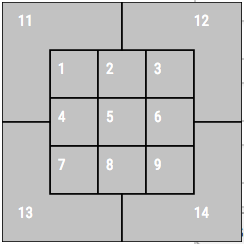
Given that we’re interested in how sustainable Rosario’s uptick in power is, let’s take a look at his flyball xwOBA in zones 1, 2, 3, 11, and 12.
| Year | Zone 1 FB xwOBA | Zone 2 FB xwOBA | Zone 3 FB xwOBA | Zone 11 FB xwOBA | Zone 12 FB xwOBA |
| 2015 | .098 | .416 | .380 | .115 | .208 |
| 2016 | .253 | .581 | .015 | .019 | .201 |
| 2017 | .587 | .391 | .306 | .368 | .559 |
Combining these zones, we can see the overall increase in xwOBA, and for good measure, I’ll lump his line drives from those zones in as well.
| Year | High-Ball FB xwOBA | High-Ball FB Avg. Exit Velocity (mph) | High-Ball FB/LD xwOBA | High-Ball FB/LD Avg. Exit Velocity (mph) |
| 2015 | .278 | 88.9 | .477 | 90.2 |
| 2016 | .271 | 92.1 | .472 | 92.4 |
| 2017 | .463 | 92.3 | .555 | 93.9 |
Whether the scope of this analysis is too narrow is up to the reader, but at the very least, the preceding data confirms my suspicions. The jump in xwOBA is a translation of exit velocity increases and more optimal launch angles, indicating that Rosario put much better swings on elevated pitches last year, and he was rightfully rewarded with by far the best power numbers of his career.
Checking out some Swing% heatmaps, we could infer why he had so much success on high-balls last year. The following heat maps are in order from 2015 to 2017.


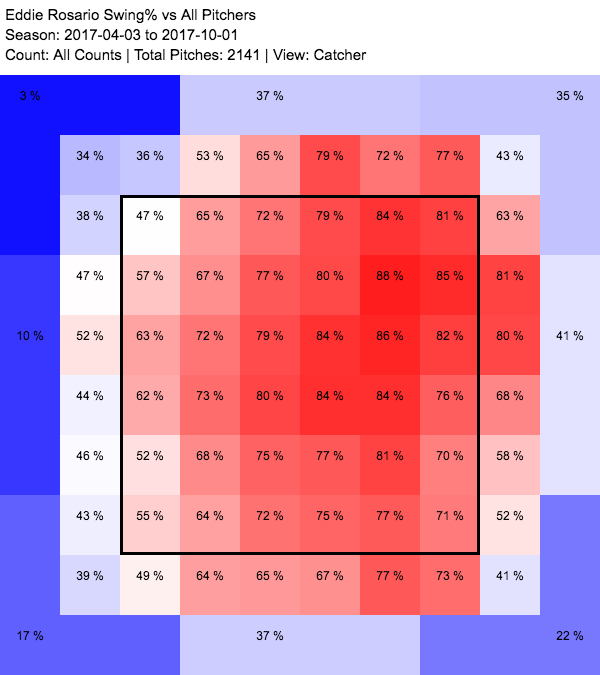
Obviously, Rosario was quite the free swinger in 2015, but he quickly shied away from the outside part of the plate the following year. Perhaps focusing on the inside edge more wasn’t quite the remedy he was after, yet it seemed to represent a step in the right direction. He was more patient on outside pitches, and that trend expanded into greater selectivity more so than passivity in 2017 where he opened up those middle-away zones a little and became even more reluctant to offer at up-and-outside pitches.
Clearly, something was up with the way Rosario approached his at-bats. And with this newfound approach, he made more contact on both outside and elevated pitches.
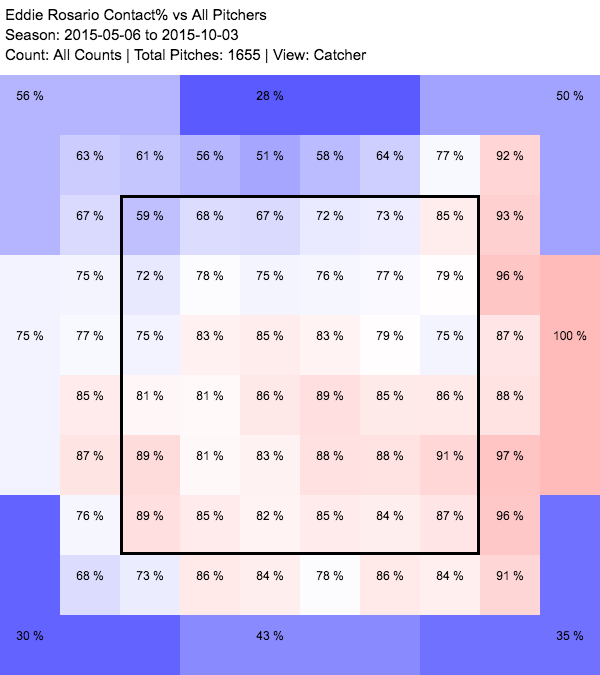
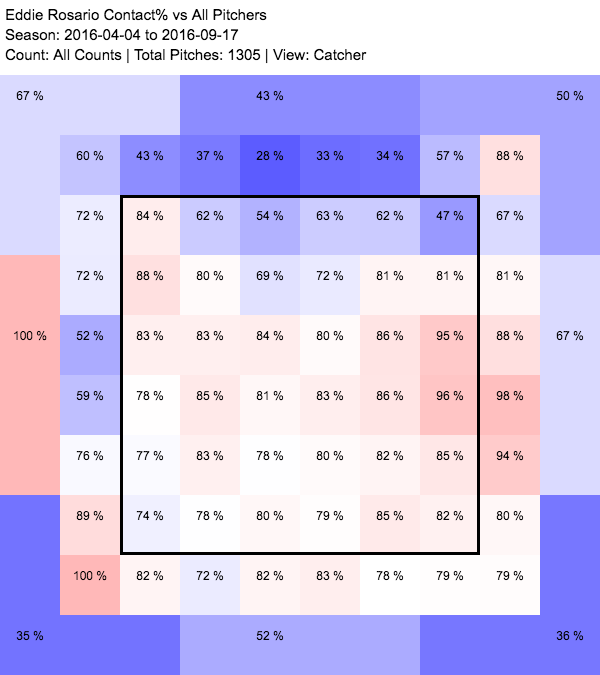
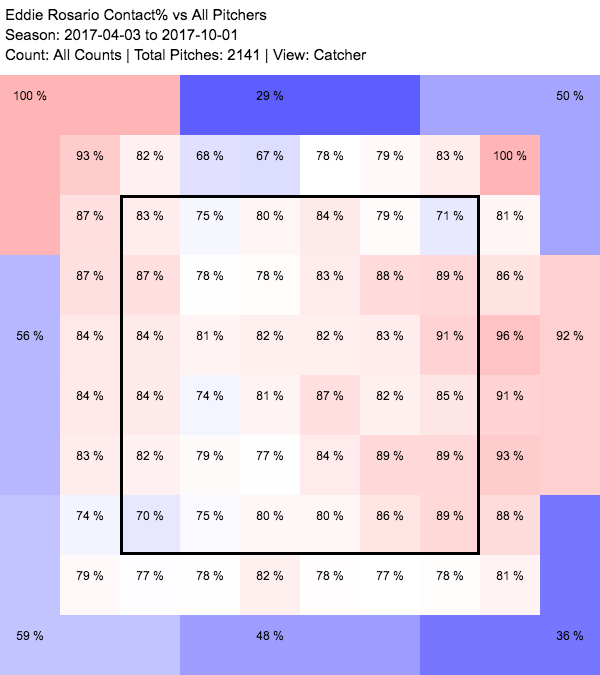
Following the logic that if he can find “his pitch,” he can make more frequent, quality contact, it seems that better judgment around the edges of the zone over the past two years has started to transform Rosario’s approach from purely aggressive to selective aggressive. We know he has the power to muscle the ball around a bit, and we know his bat-to-ball skill is great too; his success is largely just a matter of swinging at the right pitches instead of swinging at everything. Rosario wanted to be more of all-around hitter, and that’s exactly what he did.
A slow start to spring training (only 7 games and 20 PA so far) might have him showing some rust early on this season, but if he can maintain his approach, Rosario can sustain his above-average offensive performance in 2018. Actually, he must maintain this approach to remain productive. With large steps forward in BB%, K%, and HR/FB% namely, he demonstrated a clear departure from his earlier days, but if he regresses in those areas, he could dip below 100 wRC+ again.
In fact, if we take his 2017 BB% from 5.9% down to 4.5%, his K% from 18.0% up to 21.2% (league average), and his HR/FB from 16.4% down to 13.8% (league average), we get the following 2017 output for Rosario:
| Year | AVG | OBP | SLG | HR | R | RBI | SB | wRC+ | fWAR |
| 2017 | .274 | .303 | .464 | 22 | 71 | 70 | 8 | 97 | 1.2 |
Veritable skills don’t evaporate overnight, and you don’t massively improve your plate discipline stats by accident so I wouldn’t expect to see such a steep decline in production from Rosario in 2018, but it’s important to note that those modified rate stats would still represent career-bests for him. This “What If?” stat line simply highlights how important maintaining his 2017 approach will be for him this year. There is plenty potential for Rosario to post another .800+ OPS season as a selective, high-ball hitter, but his track record suggests the bottom could fall out if pitchers can effectively force him out of this new comfort zone.